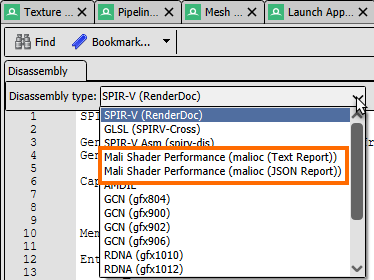Arm Performance Studio: A look back, and a look forward
Arm Performance Studio release 2024.6 release bringing you quality-of-life improvements and bug fixes. Read this blog post for more information about other features in this release.
By Peter Harris

We have just made our final Arm Performance Studio release of 2024, with the 2024.6 release bringing you quality-of-life improvements and bug fixes. Some of the larger improvements include:
- Frame Advisor is starting to show advice, with color highlighting in the Content Metrics view, to indicate “bad” draw calls that should be optimized. You can set the Color ramp threshold in the Display settings of the Configure –> Preferences dialog.

- Frame Advisor visualizations for the Render Graph and Detailed Geometry Metrics views have been revisited and improved, incorporating developer feedback and ideas that we have had this year.

- RenderDoc for Arm GPUs now supports generating Mali Offline Compiler reports from within the RenderDoc shader view, for quick and easy shader analysis. See the User Guide for detailed instructions.
- Frame Advisor now shows transfer workloads in the Frame Hierarchy view, which is the first step towards full non-render-pass workload support landing in 2025,more on that later.
- Streamline’s Timeline view renderer has been optimized, so it is faster to refresh when moving around with many charts visible on high screen resolution screens.

A look back at 2024
2024 has been a busy year for our engineering team, with the move to a faster release cadence meaning we are now shipping a new release every 6 weeks. The faster cadence means that not every release includes major new features, and it’s easy to miss some if you skip a release, so I wanted to recap the major product highlights from this year.
Hello, Arm Performance Studio
Our first release this year introduced Arm Performance Studio to the world, replacing the Android-focused Arm Mobile Studio with an enhanced free-of-charge bundle that added Arm Linux support. This enables developers using our tools to optimize their software for a wider range of platforms, spanning embedded devices to cars to Arm Neoverse servers.
Hello RenderDoc for Arm GPUs
Not satisfied with only adding a whole new target OS, Arm Performance Studio 2024.0 also made the first release of our fork of RenderDoc, RenderDoc for Arm GPUs.
This year, the team have added support for applications using Vulkan ray query and opacity micromaps, as well as taking on upstream bug triage for Android and adding many workarounds for Android device quirks and compatibility issues. To ensure that the community benefits from our changes, we are contributing as many of our changes to the upstream project as Baldur is willing to accept.
Frame Advisor starting to mature
Arm Frame Advisor, our new API-aware profiling tool, has just celebrated its first birthday. Like many new software products, our first release had missing features and, yes, also had its fair share of bugs. Throughout this year we have been busy improving both the usability and reliability of the existing features, as well as starting to work our way down the feature request.
There have been so many changes this year it’s hard to select just a few, but the major feature highlights include:
- New Mesh view for visualizing geometry
- New Program or Shader view for showing Mali Offline Compiler metrics, shader source code, and SPIR-V disassembly
- Support for HDR color and depth images in the Framebuffer view
Despite being busy with features the team have also managed to squash numerous bugs and have also revisited and refreshed the UI or UX for nearly every part of the tool that we shipped in the 1.0 release last year.
My personal highlight of the year was taking Frame Advisor to the Games Developer Conference in March, and getting to see the reaction of developers who were using it for the first time. It’s a tool that tries to make GPU performance more accessible, and it was great to see so many developers having a positive first impression and managing to work their way around the tool with no prior experience.
Streamline
The major focus for the Streamline team this year has been to refresh our software profiling capabilities. This is part of the tool that has not had as much love in recent years, because we have been focusing on improving the Android user experience and Arm GPU support, so this is somewhat overdue.
The major feature development this year has been the creation of a new native software profiling analysis backend. This enables much faster and more memory efficient analysis, an essential property when trying to profile Arm Neoverse systems with more than 100 CPU cores. It also supports function-attributed top-down profiling metrics, a new methodology for Arm that has been rolling out the latest Arm CPUs, as long as your software is running on a new enough Arm CPU to have the necessary performance counters. The new data analysis tool is shipping already as a standalone Command Line tool for Arm Neoverse servers, and will soon be integrated into the GUI to bring significantly faster data analysis to everyone.
A roadmap for 2025
We value developer feedback and use all of the feedback we get to improve the tools and prioritize our plans. In that light, we thought it would be useful to end with a review of what you can look forward to in 2025. Let us know what you think.
Streamline
The top three major roadmap items for Streamline next year are:
- Merge the new data processing backend making it possible to analyze longer software profiles from larger systems. Existing users can expect a nice performance bump and a more responsive tool, even if performance today is not of major concern.
- Enhance all software profiling data visualizations within the tool. This includes refining existing views, addressing usability issues, and introducing new visualizations to support top-down metrics. These improvements will be delivered incrementally throughout the year, instead of as a single large update.
- For Arm GPUs, the primary priority is to enhance the next generation of the Arm Mali Timeline visualization and the GPU scheduling event trace visualization. Plans include improving the usability of the Streamline Timeline view to better support event-based use cases, incorporating dynamic analog zoom control instead of fixed zoom levels. Additionally, there are plans to add more detailed API-aware data to the scheduling visualization, made possible by enhanced workload tagging in the latest generation of Arm GPU drivers.
Frame Advisor
We have a long roadmap of features for Frame Advisor, but the top three are:
- Add support for remaining workload types, including compute dispatches, trace rays dispatches, and transfer workloads.
- Support advanced draw call types, including indirect and multi-draw indirect calls.
- A new visualization feature that extends the Content Metrics and Detailed Content Metrics views to display performance-sensitive render states used by draw calls. It includes templates that enable users to switch between analysis types and create custom reports.
RenderDoc for Arm GPUs
We have some exciting work items on the RenderDoc roadmap for new hardware we cannot discuss yet. However, our top two focus areas are:
- We are collaborating with Baldur to add support for Vulkan ray tracing pipeline extensions.
- We are adding support for per-workload performance counters, enabling collection of per render pass and per compute dispatch performance feedback from the hardware.
Visit us at GDC
Planning to attend the Games Developer Conference in 2025? We’ll be hosting some technical talks on Android optimization and other mobile development topics. Visit our expert bar on Tuesday March 18th for insights on using Arm Performance Studio tools and other Arm technologies to enhance your mobile games.
We hope you enjoy Arm Performance Studio 2024.6, and will talk to you all again in 2025!
By Peter Harris
Re-use is only permitted for informational and non-commercial or personal use only.
